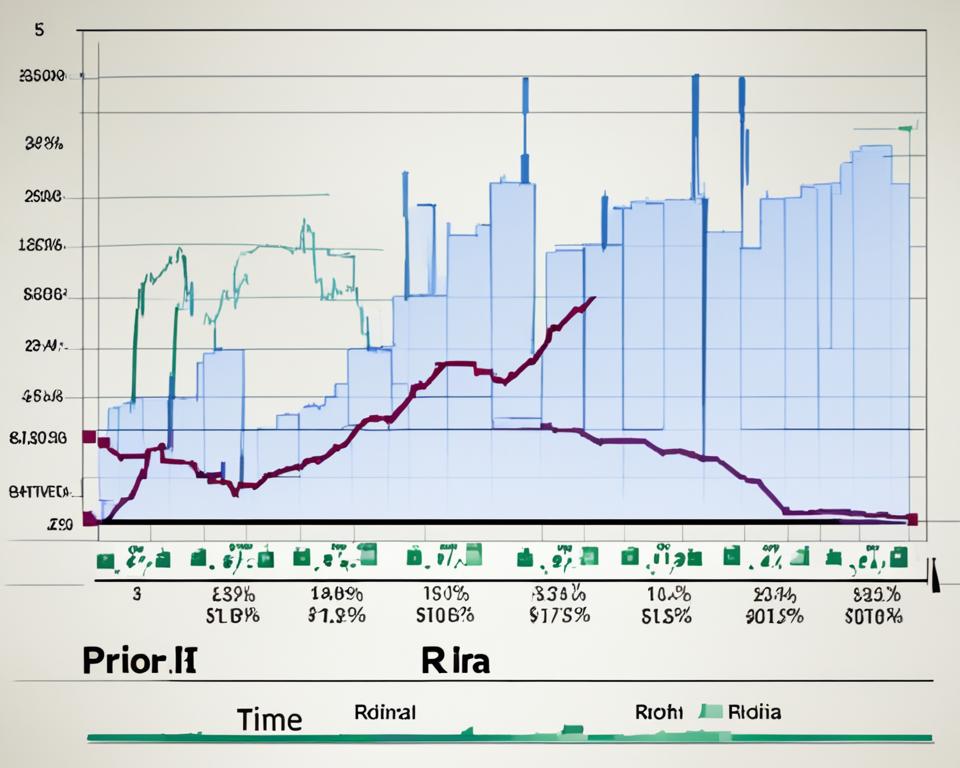As an astute investor, you’re always aiming to maximize the potential of your portfolio, especially when it comes to yield-generating assets. Knowing when to sell dividend stocks is as crucial as picking them. It’s not just about watching your dividends roll in; it’s about savvy sell dividend stocks decision-making. Have you mastered the art of timing your trades, particularly in capturing that coveted dividend payout? Let’s delve into the strategy that has day traders buzzing—the dividend capture approach—as we uncover the best time to sell dividend stocks and how to capitalize on those significant payouts without compromising your investment goals.
The dividend capture strategy stands out for its unconventional approach. Instead of holding on to dividend darlings for the long haul, it’s a tactical sprint to the payout line. By understanding the nuances of this strategy and keeping an eye on pivotal dates, such as the ex-dividend date, you position yourself to make informed decisions, ensuring that your portfolio dances to the rhythm of the market’s pulse.
Key Takeaways
- Discover the art of timing when to sell dividend stocks for optimal portfolio performance.
- Understand the dividend capture strategy as a dynamic approach to income-focused trading.
- Recognize the importance of the ex-dividend date in your sell dividend stocks decision-making.
- Leverage actionable insights to navigate market volatility and capture desirable dividends.
- Align your selling tactics with the broader picture of your investment objectives.
- Embrace flexibility in strategy to adapt to ever-changing market conditions.
- Utilize key financial information to make educated selling choices that boost your portfolio’s yield.
Understanding Dividend Capture Strategy
Are you intrigued by the notion of an income-focused stock trading strategy that may allow you to reap dividends in a shorter timeframe? If so, the dividend capture strategy might be a technique worth exploring. As the name suggests, it’s a tactical move aimed at ‘capturing’ a stock’s dividend through timely buying and selling maneuvers.
The essence of this strategy is not about long-term investment in a company’s growth potential but rather about short-term gains through dividends. By honing in on the critical timing to sell dividend stocks, traders can potentially skirt around the otherwise steady pace of traditional investment portfolios, looking instead for quick, successive wins. Dive into this strategy with us to understand its mechanics and how it can fit into your trading repertoire.
Basics of Income-Focused Trading
Dividend capture strategy is a bit like the sprint of the investing world. At the core of this strategy is the precise timing of both buying and selling stocks to secure the payment of dividends. This method appeals to those who seek regular income streams from their investments but are not particularly inclined to hold onto stocks for extended periods.
You’ll often find day traders leveraging this approach, but it has also attracted investors who are comfortable with its active trading demands. These traders typically scour the market for stocks with impending dividend payouts, positioning themselves to buy just in the nick of time to qualify for dividends and then promptly selling the stocks post-payout.
Examining Short-Term Holding to Capture Dividends
What sets dividend capture apart from other strategies is the brief holding period. While buy-and-hold investors are content to wait months or even years to see dividends, those using dividend capture might hold a stock for only a matter of days or, in some cases, just one day. This abbreviated holding period is essential to the strategy because it revolves around the timing to sell dividend stocks. The goal here is to hop in just before a stock goes ex-dividend and hop out once the dividend is secured, ideally without the share price taking too much of a hit in the process.
Stock Price Behavior Around Ex-Dividend Dates
Stock price movement around ex-dividend dates holds the key to understanding when to sell dividend stocks. In an ideal scenario, a stock would fall by the exact dividend amount on the ex-dividend date. In practice, the market’s many variables mean that this price drop might be more or less than the actual dividend.
The success of the dividend capture strategy relies on this discrepancy. If the stock price falls less than the dividend amount, there is an opportunity for a profit. It’s not without its risks—market fluctuations can just as easily sway the other way, eroding the expected gains of the dividend payout. Consequently, those employing the dividend capture strategy must keep a vigilant eye on market sentiment, corporate announcements, and broader economic indicators that could affect stock prices leading up to the ex-dividend date.
Remember, the efficiency of the market means the strategy isn’t fool-proof, and profits aren’t guaranteed. Taxes, transaction costs, and market movements all play pivotal roles in the outcome of this trading approach.
The Core Dividend Dates Every Investor Must Know
Understanding the dividend dates within a company’s dividend timeline is essential—particularly for newcomers eager to learn when to dispose of dividend stocks. These pivotal moments in the dividend cycle dictate your eligibility for dividend payments and influence the strategic timing of buying and selling to optimize your investment returns.
Declaration Date: Starting Point of the Dividend Timeline
The declaration date marks the official announcement from a company’s board of directors that a dividend will be paid. It is the flag-bearer of the entire dividend timeline, signaling shareholders about upcoming dividends and setting the stage for all subsequent actions.
Ex-Dividend Date: Critical Cut-Off for Dividend Eligibility
Arguably the most crucial date for investors, the ex-dividend date marks the threshold at which new buyers of a stock no longer qualify for the most recent dividend. Stocks often experience a price drop on the ex-dividend date, reflecting the amount of the dividend paid. Astute investors keenly observe this date to determine the opportune moment for executing transactions.
Record Date and Pay Date: Understanding Their Relevancy
Close on the heels of the ex-dividend date is the record date, which is when the company reviews its records to determine which shareholders are entitled to the dividend. Following this, the pay date arrives, and it’s the moment shareholders eagerly await, as it’s when the dividends are disbursed. Timing your investment activities around these dates is critical for those who adopt the dividend capture strategy, hoping to maximize their yield without a long-term commitment to the stock.
In conclusion, knowing the significance of each date in the dividend timeline helps map out an effective investment strategy. Whether you are planning to keep or dispose of dividend stocks, these key dates are instrumental in shaping your decision-making process.
Utilizing Options for Dividend Capture
When it comes to enhancing your investment strategy, particularly for those focused on dividends, using options for dividend capture can equip you with more sophisticated tactics. This advanced form of trading allows you to leverage the inherent versatility of options to potentially secure greater returns from your dividend plays. For investors pondering when to offload dividend stocks, options provide a nuanced approach that could align with both market conditions and individual financial goals.
Advanced Strategies with Options Trading
Options trading strategies lend themselves well to the tactics of more experienced investors. While straightforward stock purchases based on dividend timelines offer one route to returns, options open the door to potentially greater gains. By taking positions in call or put options prior to a stock’s ex-dividend date, you establish a chance to capitalize on the expected drop in stock price once the dividend is paid—without the need to commit large amounts of capital to stock ownership.
Maximizing Dividend Yields Through Options
Maximizing your returns from dividends can be a fine art. As part of this process, you might purchase call options if you anticipate the stock’s price will rise or put options if you expect it to drop post-dividend issue. The strategic use of options serves as a flexible complement to traditional strategies of buying and holding dividend stocks, particularly useful when to offload dividend stocks falls into question amid market uncertainties.
| Options Strategy | Description | Potential Benefit |
|---|---|---|
| Buying Calls Prior to Ex-Dividend | Purchasing the right to buy the underlying stock at a set price before it pays a dividend. | Profit from a potential rise in stock price with limited investment. |
| Selling Puts Before Ex-Dividend | Selling the right to sell the underlying stock at a pre-determined price. | Capture premium income, possibly owning the stock at a lower cost if assigned. |
| Covered Calls for Dividend Stocks | Selling call options on stocks you already own and are set to receive dividends. | Earn additional income from premiums while waiting for the dividend. |
| Protective Puts on Dividend Stocks | Buying put options to hedge against potential price drops post-dividend. | Protect your holdings from significant losses while capturing dividends. |
When to Sell Dividend Stocks
As an investor in dividend-paying shares, determining when to sell dividend stocks is a key decision that requires careful consideration of various factors. It’s not merely about catching the next dividend payment; it’s about maximizing overall investment returns. The optimal time to sell dividend stocks can hinge on market conditions, corporate dividend payout sizes, and personal investment strategies focused on either capturing dividends strategically or banking long-term gains.
Whether you’re playing the short game through active trading or focused on the long-term holding of assets, the question of timing draws upon several critical elements. Market volatility can influence stock prices significantly, especially around the ex-dividend dates, making it essential to have your finger on the pulse of market trends. In addition to these, your own tax situation may affect the net benefit of your investment, potentially altering the outcomes of a sale.
Let’s delve into an illustrative scenario which highlights these various factors:
| Market Condition | Dividend Payout | Investor’s Strategy | Tax Implications | Decision Factor |
|---|---|---|---|---|
| Stable market, minimal volatility | High | Long-term growth | Qualified dividend | Favorable long-term holding |
| Bearish market, increased volatility | Medium | Dividend capture | Ordinary income rate | Potential short-term sale |
| Bullish market, expectations of growth | Variable | Mixed method | Depends on holding period | Evaluate price trends and dividend forecast |
When considering optimal time to sell dividend stocks, weighing the potential short-term profits against long-term investment goals becomes paramount. Ask yourself: will the immediate gains from selling and capturing the dividend outweigh the benefits of holding the stock? Will the price adjustment on the ex-dividend date negate the benefits of the dividend payment itself? How will the decision align with your overall financial plan? These are questions central to your selling strategy.
In essence, selling dividend stocks should never be a hasty choice. Taking a methodical approach that accounts for market analysis, company performance, and individual financial circumstances will elevate your investment strategy from one of happenstance to one of deliberate calculation. Indeed, mastering when to sell dividend stocks means blending the science of market analysis with the art of timing.
Analyzing the Financial Viability of Dividend Capture
When navigating the landscape of dividend investing, the allure of a strategy that focuses on frequent, quick payouts is undeniable. However, the success of such an approach hinges on thoroughly understanding the financial viability of dividend capture. This includes not just the surface-level allure of payouts, but also a deeper dive into the long-term sustainability of these strategies—especially when considering the impacts of taxes and the compound effect of consistent captures on overall returns.
Compounding Returns with Frequent Captures
One might consider the dividend capture strategy akin to reaping a harvest throughout multiple seasons in a year. By skillfully maneuvering around ex-dividend dates, an investor can, in theory, harvest dividends repeatedly, leading to a compounding effect on returns. This process of capturing dividends from various stocks throughout the year plays a pivotal role in potentially increasing the investor’s income.
- Intensive market scanning for dividend-paying stocks
- Utilization of dividend calendars for precise timing
- Frequent transactions to capitalize on payout periods
Yet, it’s not the sheer number of captures that matters, but the actual returns after each transaction. Selling dividend stocks strategy demands awareness of price movements and keen perception of when the captured dividends surpass any associated costs or losses from stock price dips.
Considering Tax Implications in Profit Calculation
The allure of consistent dividends may dim when faced with the harsh reality of taxation. The tax treatment of dividends from a short-term dividend selling stocks strategy can erode the apparent gains. As dividends from these strategies are typically taxed as ordinary income, not qualifying for lower capital gains rates, the investor needs a meticulous dividend capture profit calculation to ensure their efforts yield actual financial benefits.
| Strategy Element | Financial Impact | Tax Consideration |
|---|---|---|
| Dividend Income | Potential Compounded Gains | Taxed as Ordinary Income |
| Transaction Frequency | Elevated Brokerage Costs | Short-term Capital Gains |
| IRA Trading Account Usage | Tax-deferred or Tax-free Growth | No Immediate Tax Impact on Dividends |
For some, a mitigating strategy can be the use of IRA trading accounts where dividends grow tax-deferred or even tax-free, reshaping the financial landscape of dividend capture. Indeed, the savviest investors often embed their dividend strategies within such tax-advantaged confines, optimizing the benefit of their well-timed captures.
In conclusion, delving into the financial viability of dividend capture means meticulously putting each piece of the puzzle in place, from the compound potential of frequent captures to the tax implications that might challenge their profitability. For the income-seeking investor, such a keen eye for detail can make the difference between merely participating in the market and truly profiting from it.
The Role of Market Efficiency in Dividend Selling Strategies
Within the realm of stock trading, particularly with regard to dividend selling strategies, the concept of market efficiency is paramount. While some investors adore the notion of “free lunch” by practicing dividend capture strategies, the reality rooted in market efficiency poses some important questions. To what extent can you rely on such strategies in a market environment where every opportunity seems accounted for? Let’s delve into how market efficiency challenges easy profit theories and the influence of high-speed trading on the dividends game.
Challenging the “Free Lunch” Notion in Markets
You’ve likely come across the adage that there’s no such thing as a free lunch—this is especially true in the context of stock markets. Market efficiency scrutinizes every technique, including the favored dividend selling strategies. In an efficient market, stock prices would accurately reflect all available information, which includes forthcoming dividend payments. Subsequently, stock prices should theoretically decrease by the dividend payout amount on the ex-dividend date, leaving no room for easy profits.
However, markets are not always picture-perfect in their efficiency. Various factors, ranging from investor sentiment to external economic news, influence stock prices, creating a divergence from the idealized adjustments. This unpredictable nature of the market allows the strategy some room to maneuver, though it never guarantees success. Your role as an investor is to critically assess the potential of any share before its ex-dividend date, gauging whether the profit margin after the price adjustment is worth the strategy’s implementation risk.
Computerized Trading and Its Impact on Dividend Strategies
The advent of computerized trading has brought about a radical change in the way markets operate. High-frequency trading algorithms can analyze and act on market information in microseconds, affecting stock prices, including those undergoing dividend-related trades. As a result, these automated systems can potentially exploit any observable pattern, including those that dividend capture strategies rely upon.
A crucial point to consider is the impact of computerized trading on dividends. If there were indeed consistent profits to be had through dividend selling strategies, it stands to reason that these sophisticated systems would have already capitalized on them extensively. Consequently, the mere presence of automated trading suggests that any market inefficiencies are likely to be short-lived and exploited rapidly, prompting you to be ever so vigilant in your trading decisions.
In summary, while there is always an opportunity to make profits, you must be aware that earning from dividend selling strategies is not a simple task in today’s efficient and computerized market environment. Your success hinges upon understanding the nuances of market efficiency, the speed of modern transaction systems, and the ability to act swiftly and knowledgeably.
Assessing the Risks of Dividend Capture Approach
Understanding the risks of the dividend capture strategy is crucial if you’re considering this active trading method to enhance your income. This technique looks straightforward on paper, but in practice, it’s far from a sure bet. Let’s peel back the layers and examine the risks that might chip away at your profits, or potentially even dip into your capital.
Firstly, consider the inherent risk of the stock price falling more than the dividend amount after you’ve made the capture. In such cases, your sale may result in a net loss rather than a profit. Moreover, selling dividend stocks strategy risks are amplified by market volatility, which can unpredictably affect stock prices and dividend payouts—timing is everything, and unfortunately, timing can be unpredictable.
To illustrate this point, imagine a scenario where you utilize the dividend capture strategy, but on selling the stock, you find that its price has fallen significantly more than the dividend you were expecting. This decrease may lead to a situation where the dividend payment doesn’t cover the loss incurred from the sale of the stock itself. Now, not only is your net gain diminished, but you’ve also incurred a capital loss on your initial investment.
This strategy also raises another nuance—the concept of the dividend irrelevance theory. This theory posits that dividends don’t significantly affect the stock price as they are an allocation of existing assets rather than a creation of new value. Moreover, frequent buying and selling of stocks to capture dividends can result in opportunity costs—funds used in such an approach could alternatively be invested in other stocks with potential for appreciation.
| Potential Outcome of Dividend Capture | Impact on Profit | Market Influence at Play |
|---|---|---|
| Stock price drops more than dividend amount | Potential Net Loss | Market Volatility and Sentiment |
| Stock price minimally affected by dividend payout | Marginal Profit or Breakeven | Market Efficiency and Rational Pricing |
| Stock price rebounds or rises post-dividend | Possible Gain | External Economic Factors or News |
If you’re looking to employ the dividend capture strategy effectively, consider both the short-term gains and the long-term implications on your investment profile. Ensure you’re not just chasing dividends but that you’re also considering the overall health and growth potential of the stocks you select. Stay vigilant and informed, as assessing the risks of the dividend capture approach can mean the difference between a strategically sound decision and a costly misstep in your investment journey.
What Makes Dividend Investing Sustainable?
When charting a course through the investing seas, you may find yourself questioning the sustainability of dividend investing. Sustainability here is not about the latest green initiative—but the ability of a company to continuously provide dividends without stretching itself thin financially. Wise investors dig beyond the allure of immediate payouts to discern the longevity of dividend yields. In this thoughtful journey, we debunk prevalent myths surrounding high payouts and examine a pivotal financial theory stirring the world of dividends.
The Myth of the High Dividend Yield
Floating amidst the ocean of investment opportunities, the siren song of high dividend yields can be tempting. Yet, you might be wary of the high dividend yield myths and look beneath the surface. These enticing yields can sometimes be the harbinger of unsustainable practices. Why does this matter? Because companies offering sky-high payouts might not be investing enough back into their businesses, potentially jeopardizing future profitability and dividend stability.
Astute investors know that the gloss of a high yield today might come at the cost of a dwindling capital stock tomorrow. So, as you weave through your investment options, consider companies that balance paying dividends with reinvesting in growth—this is where the true sustainability of dividend investing shines.
Dividend Irrelevance Theory: Merits and Criticism
A theory cultivated in the academic fields and scrutinized in the financial markets is the dividend irrelevance theory. It implies that the dividend policy of a company is of little significance in terms of affecting its market value. The exponents suggest that investors should be ambivalent whether a firm distributes profits as dividends or reinvests them into expanding the enterprise.
But does the sentiment hold in the practical world? Critics argue that dividends are indeed relevant, serving as signals of financial health and providing immediate returns. Real-world evidence often shows a company’s share price responding to dividend announcements, suggesting that the market considers dividends to be far from irrelevant. Meanwhile, investors in high tax brackets may prefer capital gains over dividends due to their tax advantages.
In summary, while the dividend irrelevance theory provides food for thought, it is the prudent assessment of a company’s long-term profitability and dividend policy that will guide you toward sustainable dividend investing.
Recognizing the Psychological Influence on Dividend Stock Sales
When deciding whether to hold or sell dividend-yielding stocks, have you considered the psychological undercurrents influencing your choices? The psychological effects on selling dividend stocks are not to be underestimated. Emotions can run high during periods of market volatility, swaying decisions and clouding judgment. It’s important to recognize these subconscious influences to navigate the tumultuous waters of stock trading effectively.
Human Behavior and Market Volatility
Market conditions can pose a perplexing challenge, especially when stocks swing unpredictably. Volatility often triggers an emotional response from investors, whether it’s the rush of optimism in a bullish market or the grip of fear during a downturn. Behavioral finance teaches us that your decisions to sell dividend stocks might be steeped in reactive tendencies rather than strategic planning. Emotions can sometimes lead to premature selling or holding onto stocks for too long, potentially resulting in missed opportunities or unanticipated losses.
Investment Horizon and Its Impact on Selling Decisions
Unlike market timers who might ride the waves of short-term gains through strategies such as dividend capture, your investment horizon could dictate a very different approach. If your focus is set on the horizon—seeking stable growth and sustainability of dividend income—your strategy in selling dividend stocks will likely reflect that patience. This long-term perspective can serve as a bulwark against the fickle winds of market volatility, offering stability in your decision-making process.
Consider the following scenario as an illustrative example:
| Investor Profile | Behavioral Tendency | Market Volatility | Investment Horizon | Action |
|---|---|---|---|---|
| Day Trader | High reactivity to market changes | Intense fluctuation | Short-term | Sell to capture dividend and possibly reinvest |
| Retirement Saver | Low reactivity, prioritizes stability | Moderate fluctuation | Long-term | Hold to accumulate dividends over time |
| Growth Investor | Aversive to losses, seeks long-term value | Mild fluctuation | Intermediate to long-term | Evaluate potential growth versus immediate returns |
As you map out your stock selling strategies, take a moment to reflect inward—understanding your investment horizon and how it matches your fiscal goals is essential. Meanwhile, staying cognizant of the psychological effects market volatility might impose ensures that when you sell, it’s a decision based on logic and planning, not whims or fears.
Optimal Time to Sell Dividend Stocks: A Strategic Overview
When pondering the best time to sell dividend stocks, it is not just a question of following the crowd but rather devising a personalized dividend stocks selling strategy that addresses a myriad of factors. The timing chiefly rests on dividend payment schedules, company performance forecasts, prevailing market trends, and, importantly, your individual financial aspirations.
To construct a strategy that serves your long-term wealth ambitions, you’ll first need to dissect the intricacies of the dividend payment timeline—weighing the significance of declaration dates against your entry and exit strategy.
Meticulous consideration must be given to the adverse consequences of selling too soon or too late, as each stock comes endowed with its own set of behavioral tendencies around dividend handouts. A key element to consider, in tandem with these chronological nuances, is the influence of tax implications post-dividend capture, which must not be overlooked if net profit realization is the endgame.
Furthermore, we must assess the interplay between stock performance projections and actual market movements. It is paramount that you monitor these market shifts diligently, adjusting your dividend stocks selling strategy in response to oscillations that could impact your returns.
| Factor | Consideration | Impact |
|---|---|---|
| Dividend Payout Schedule | Timing sell around peak payout periods | Capitalize on maximum dividend returns |
| Stock Performance Projection | Anticipating price movement in relation to dividend announcement | Minimize potential price drop impacts post-dividend payout |
| Market Trends | Aligning sale with broader market sentiment | Enhanced positioning for favorable stock liquidity |
| Financial Goals | Personal benchmarks for return on investment | Staying true to your broader investment strategy |
While dividend stocks may serve as strongholds of stability in a diversified portfolio, their disposition should be orchestrated with precision. It’s a delicate balance—striving for an optimal time to sell dividend stocks entails encompassing a bird’s-eye view of the financial landscape, ensuring that when you choose to divest, it marries well with your overall investment choreography. Be dutiful in your approach, and you might just harness the full potential of dividends to propel your portfolio forward.
Conclusion
As we reach the closure of our comprehensive journey through the world of dividends, your newfound knowledge equips you with smart timing tips for selling dividend stocks. This arsenal of strategic insights will serve as your compass, helping you navigate the ebb and flow of the markets with precision. Remember, the robustness of your portfolio depends not just on the stocks you choose but also on your mastery of the timing of each sale. Informed decision-making, underpinned by a thorough understanding of the dividend capture strategy and market dynamics, is essential in your quest for investment longevity.
Key Takeaways on Smart Timing to Sell Dividend Stocks
Throughout this exploration, we’ve underscored that the optimal sale of dividend stocks is not a one-size-fits-all solution but a nuanced art that is highly personalized. Be vigilant about key dates, attuned to market volatility, and cognizant of the effects of taxes on your potential profits. Whether you’re leveraging traditional buy-and-hold approaches or the more agile dividend capture strategy, being strategic with your timing is imperative. With every transaction, permit these smart timing tips to guide you, ensuring that each move aligns seamlessly with your overarching financial objectives.
Final Thoughts on Dividend Capture and Investment Longevity
In your pursuit of prosperity, the thrill of short-term gains via dividend capture investment longevity should be balanced against the pursuit of sustainable long-term growth. While the dividend capture strategy may offer fleeting opportunities for profit, be mindful of its inherent risks and the tax ramifications that can accompany swift trading. Ultimately, the decision to hold or sell dividend stocks should resonate with your investment ideology, one that cherishes both the sprint for immediate rewards and the marathon towards enduring wealth. Carry forward these insights, and may your investments be as fruitful as the dividends they yield.
FAQ
When should you consider selling dividend stocks?
You should consider selling dividend stocks when they no longer align with your investment strategy, the dividends are cut or no longer sustainable, when the stock price has appreciated to a target level, or when market conditions indicate a potential decline. Additionally, if you need to rebalance your portfolio or have a better investment opportunity, it may be the right time to sell.
What is a dividend capture strategy?
A dividend capture strategy is a type of stock trading method where an investor buys shares of a stock before the ex-dividend date and sells them after the dividend payout. The goal is to earn the dividend without holding the stock long-term, but this tactic requires careful timing and awareness of market behavior around dividend dates.
How do stock prices typically behave around ex-dividend dates?
Stock prices usually drop by the amount of the dividend on the ex-dividend date, reflecting the payout made to shareholders. This anticipated drop is an important factor for those implementing a dividend capture strategy, as it can affect profitability.
Can options trading be used with a dividend capture strategy?
Yes, options trading can be used alongside a dividend capture strategy. By employing options, investors can potentially minimize risk or maximize gains based on expected stock price movements around ex-dividend dates.
What should you consider when determining the best time to sell dividend stocks?
When trying to determine the best time to sell dividend stocks, consider market conditions, dividend stability and growth, company performance, your own investment goals, and how the sale affects your portfolio’s balance. Also, factor in tax implications and transaction costs to ensure monetary gains align with your expectations.
How do taxes impact the financial viability of a dividend capture strategy?
Taxes significantly impact the viability of a dividend capture strategy because dividends from short-term trades are taxed at the higher ordinary income rates rather than the lower qualified dividend rate. The strategy may be more favorable in a tax-advantaged account like an IRA, where the tax impact is deferred.
Does market efficiency affect dividend selling strategies?
Yes, market efficiency plays a role in dividend selling strategies. If markets were perfectly efficient, stock prices would adjust exactly by the dividend amount on the ex-dividend date, potentially negating profits from a dividend capture strategy. However, inefficiencies do occur, which is what such strategies aim to exploit.
What are some risks associated with the dividend capture approach?
Risks include the stock’s price dropping more than the dividend amount, thus eroding potential profits, and market volatility, which could lead to losses outweighing the benefits of the dividend. Additionally, the approach can incur higher transaction costs and tax liabilities.
What factors contribute to the sustainability of dividend investing?
Sustainable dividend investing is supported by realistic and balanced dividend yields, sound company fundamentals, a consistent track record of dividend payments, and the ability of a company to grow earnings over time. A high dividend yield that’s not supported by profits may indicate an unsustainable payout.
How does an investor’s psychology influence when to sell dividend stocks?
Investor psychology can influence decisions to sell dividend stocks through emotional reactions to market volatility and the attachment to the income provided by dividends. Long-term goals versus the allure of short-term gains can also play a role, prompting investors to sell based on fear or greed rather than strategic planning.
What is the optimal time to sell dividend stocks?
The optimal time to sell dividend stocks depends on your personal financial goals, investment horizon, market conditions, and specific company performance. It requires balancing the benefit of future dividend payments against the potential capital gains from selling while also considering tax implications and transaction costs.












